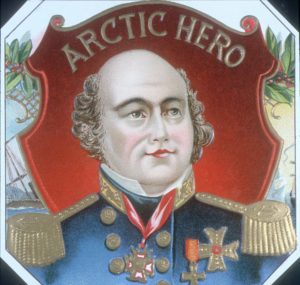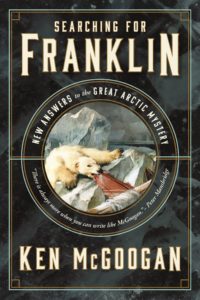Debunking the Dead Hero Myth

Sir John Franklin
Searching for Franklin a vivid account of the ill-fated expedition doomed by the hubris of its leader
Review by Jamie Portman / Postmedia News for National Post, Montreal Gazette, Ottawa Citizen, Calgary Herald, Edmonton Journal, Vancouver Sun, Windsor Star and other publications
I have a feeling that history is on the ropes at our schools and universities and what I’m trying to do is to take a ‘creative’ non-fiction’ approach. — Ken McGoogan
Arctic historian Ken McGoogan’s breathtaking new book, Searching for Franklin, often reads like a detective thriller — and with good reason. After all, the multi-award-winning McGoogan is probing a mystery that has engaged us for more than 175 years. Sir John Franklin’s quest to find the fabled Northwest Passage led to the deaths of 129 men, including Franklin himself.
But even the recent discovery by Parks Canada of the 1845 expedition’s two doomed vessels has failed to provide satisfactory answers to the ultimate question.
“Other explorers of the period lasted four winters in the Arctic and managed to survive,” McGoogan says by phone from his home outside Toronto. “So why did the Franklin expedition fall apart so early? Why did they need a hospital tent? Why were so many officers compared to crew dead by 1848?”
Artifacts recovered from the abandoned vessels don’t really provide the answer Neither dues the evidence of unbelievable hardship, including the probability of starving crew members driven to cannibalism. As for the long-standing theory that lead poisoning caused so many deaths – that has been largely discredited. By the end of his book, McGoogan submits his own bold conclusion The consumption of parasite- ridden poar bear meat was the culprit. “The answer to me is that they ate infected meat. The answer is trichinosis.”
Furthermore, McGoogan sees this a tragedy that needn’t have happened, and, in explaining why, he pursues a larger question. What was Sir John Franklin — still enshrined in many minds as a heroic figure — really like? Franklin has been a recurring presence in McGoogan’s writing, but this time we get a closer look at a complex, contradictory figure who led a succession of failed expeditions and whose haloed nobility seems largely undeserved.
In seeking an explanation, McGoogan moves away from that final icebound tragedy, back to the year 1819 and Franklin’s leadership of an overland Arctic expedition – a leadership that, while testifying to Franklin’s unquestionable courage, also revealingly lays bare his hubris, arrogance and foolishness.
There‘s a raw immediacy, a forceful current of white-knuckle suspense, to McGoogan’s recreation of events that eventually saw Franklin and a handful of companions facing starvation and death in the icebound isolation of Fort Enterprise. They survived only because of the intervention of the great Dene leader Akaitcho, who dispatched three of his men to Enterprise, their sleds laden with food, skins, shoes and blankets.
.It was an 11th-hour rescue — but what was Franklin‘s response? In one of the book’s most telling moments, we learn that when told that rescue was on its way, Franklin “immediately returned thanks to the Almighty for his goodness.” God’s “throne of mercy” was to be thanked — not the Dene rescuers.

New Answers to the Great Arctic Mystery
“People have talked about Franklin as a Royal Navy man and how that shaped his thinking and his commitment to duty and so forth, McGoogan says now. “But people haven‘t really highlighted the evangelical Christian in the guy. No matter what happens, he assumes some kind of miracle will transpire.”
That ill-fated expedition gained Franklin a bizarre kind of celebrity fame as “the man who ate his boots” — an epithet that perversely glosses over the reality, which saw 11 of his 20 men lost in an ongoing Arctic horror story that grotesquely featured not only starvation and murder but also — in a ghastly portent of Franklin’s final fateful quest for glory — the real possibility of cannibalism.
A starving Franklin was licking lichen off rocks and chewing boot leather when rescuers arrived at Fort Enterprise. It‘s an image that sets the tone for the monumental failure of this and subsequent expeditions. Not to mince matters — more than half his party had died because Franklin didn‘t heed the advice of the wise and knowledgeable Akaitcho. McGoogan sees Akaitcho and Pierre St. Germain, a resourceful Metis voyageur who had earlier saved this hapless expedition from disaster, as the real heroes of this sorry saga.
“Akaitcho pleaded with Franklin not to set out on that final leg of the journey along the coast: Don’t go, there will be no food, you’re going to die. But Franklin believed the good lord would provide. So away he goes. It’s a classic case of hubris. He would not listen to Indigenous peoples.”

Ken visiting the John Rae Cairn
McGoogan is scrupulous in crediting sources. The journals kept by men like John Richardson, George Back and Robert Hood were — he emphasizes — vital to the present book. And as someone who has travelled to the Arctic so many times he can lose count, he feels deeply indebted to Indigenous oral tradition and wisdom. But back in the mid-19th century, such virtues were up against a blinkered imperialist sensibility.
McGoogan takes a close look at what he calls the “ethnocentric arrogance of imperial Britain” and quotes Canadian historian Richard C. Davis’s scathing conclusion that this culture “made it virtually impossible for Franklin to respect the traditionally evolved wisdom of Yellowlmife Indians and Canadian voyageurs, even though their assistance was crucial.” McGoogan supplements these comments with his own observation that conduct we would regard today as “insensitive, arrogant and overbearing” was viewed back then as (Davis’s words again), the “epitome of civilized enlightenment.”
As always, McGoogan had a wider purpose with this book than just examining one man’s improbable mythology. “I have a feeling that history is on the ropes at our schools and universities and what I’m trying to do is to take a creative nonfiction approach.”
His are the tools of the popular historian, a species held in sniffy disdain by many academic writers. But McGoogan, a former Calgary Herald book editor who is also a respected teacher of creative nonfiction, loses no sleep because of their disapproval.
“A lot of them don’t know how to write,” he says bluntly. “It’s all very ordered and strictly chronological — and that’s precisely what’s wrong.” He seeks to convert readers to a different approach. “Shifting points of view, juggling storylines — these are techniques that work with fiction.” In his mind such techniques can also work with serious non-fiction. “Enough of these dry, chronological, lifeless narratives! Let’s see if we can make this interesting as a work of art.”
Meanwhile, has time’s passage really shaken Franklin from his pedestal? McGoogan sees “the myth of the dead hero” as a “peculiarly British thing.” He also adds that the Franklin mythology received an additional boost from his widow, a formidable lady determined to preserve his aura of glory. Jane Franklin had earlier salvaged her husband’s reputation following his dubious performance as lieutenant- governor of Van Diemen’s Land (now Tasmania) and would later successfully campaign for rescue missions in the wake of the Northwest Passage disaster.
McGoogan devoted an earlier book, Lady Franklin’s Revenge, to her obsessive mission. And you can sense the enjoyment in his voice as he talks about her re-emergence in his new book. She’s the kind of character a historian savours. “Lady Franklin really had a terrific impact. She really created the myth of Franklin the dead hero. She insisted he had discovered the Northwest Passage when he hadn’t. And she was very good at getting statues of him placed here, there, and everywhere — even in Tasmania. She could not be stopped mythologizing Franklin.”
MARC HORTON, FORMER BOOKS EDITOR AT THE EDMONTON JOURNAL, ADDED A SHORT REVIEW ON FACEBOOK. AND I THINK IT WORTH PRESERVING HERE. . . .